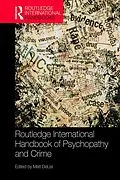For over two centuries, psychopathy has stood as perhaps the most formidable risk factor for antisocial behavior, crime, and violence. The Routledge International Handbook of Psychopathy and Crime presents the state-of-the-art on the full landscape of research on antisocial behavior that employs psychopathy as a central correlate. It is the largest and most comprehensive work of its kind, and includes contributions from renowned scholars from around the world.
Organized into five distinctive sections, this book covers the etiology of psychopathy; the measurement of psychopathy; the association between psychopathy and diverse forms of homicidal and sexual offending, including serial murder, sexual homicide, rape and child molestation; criminal careers and psychopathy; the role of psychopathy in criminal justice system supervision, including institutional misconduct, noncompliance, and recidivism.
This book is an essential resource for students and researchers in criminology, psychology, and criminal justice and will be of interested to all those interested in criminal behavior, sexual and violent crime, forensic psychology and forensic mental health.
Autorentext
Matt DeLisi is Coordinator of Criminal Justice Studies, Professor in the Department of Sociology, and Faculty Affiliate of the Center for the Study of Violence at Iowa State University, USA.
Inhalt
Part 1: Etiology of Psychopathy
1. Psychopathy and Crime Are Inextricably Linked
Matt DeLisi
2. Tracing the Effect of Psychopathy on Future Offending through Two Layers of Proactive Criminal Thinking
Glenn Walters
3. Structural Models of Personality and Psychopathy
Donald R. Lynam and Joshua D. Miller
4. Psychopathy and Empathy
Michael J. Vitacco et al.
5. Psychopathy and Emotion Regulation: Taking Stock and Moving Forward
Carlo Garofalo and Craig S. Neumann
6. Callous-Unemotional Traits: Relevance and Implications for Juvenile Justice
James V. Ray and Tina D. Wall Meyers
7. Neurogenetics Approaches to Understanding Psychopathy
Laura Murray et al.
8. The Neural Basis of Psychopathy
Shichun Ling, Rebecca Umbach and Adrian Raine
9. The Intergenerational Transmission of Psychopathy
Katherine M. Auty
10. Neurological Profiles of Psychopathy: A Neurodevelopmental Perspective
Yu Gao
11. Childhood and Adolescent Psychopathy
Olivier F. Colins and Henrik Andershed
Part 2: Measurement of Psychopathy
12. The Elemental Psychopathy Assessment
Brandon Weiss, Donald R. Lynam and Joshua D. Miller
13. Key Findings and Operational Lessons in the Measurement of Psychopathy within the Incarcerated Serious and Violent Young Offender Study
Raymond R. Corrado and Evan McCuish
14. Psychopathic Personality Traits Model (PPTM): A New Approach to Defining Psychopathy
Daniel Boduszek, Agata Debowska and Dominic Willmott
15. The PCL-R Family of Psychopathy Measures: Dimensionality and Predictive Utility of the PCL-R, PCL:SV, PCL: YV, SRP-III, and SRP-SF
Agata Debowska, Daniel Boduszek and Russell Woodfield
16. The Triarchic Psychopathy Model: Theory and Measurement
Martin Sellbom
17. The Triarchic Model of Psychopathy among Incarcerated Male Youths: A Psychometric Study
Pedro Pechorro et al.
Part 3: Homicide, Sexual Offending, and Psychopathy
18. Psychopathy and Homicide
Bryanna Fox
19. The Perpetual Influence of Dark Traits on Alienists
Enzo Yaksic
20. Psychopathy among Juvenile Homicide Offenders
Jonathan W. Caudill and Henriikka Weird
21. Psychopathy and Sexual Aggression: A Review of Empirical Research
Jesse Cale and Melanie Burton
22. Sadism, Psychopathy and Sexual Offending
Sonja Krstic et al.
23. Psychopathy and Sexual Offending
Vincent Egan and Simon Duff
24. Psychopathy and Sexuality: Impersonal and Exploitive
Beth A. Visser
25. Psychopathy and Sexual Assault
Eric Beauregard and Kylie Reale
26. The Psychopathic Sexually Sadistic Offender
Shayne Jones and Heng Choon (Oliver) Chan
27. Psychopathy and Sexual Violence
Steven M. Gillespie, Luna C. M. Centifanti, and Gayle Brewer
Part 4: Criminal Careers, Comorbidities, and Psychopathy
28. Juvenile Psychopathy and Juvenile Delinquency
Laura Lopez-Romero and Estrella Romero
29. Psychopathy and Offending Trajectories
Evan McCuish
30. Psychopathic Narcissism and Antisocial Behavior
Shari R. Reiter, Christopher T. Barry and Julie R. Odom-Dixon
31. Developmental Pathways to Adolescent Callous-Unemotional Traits: The Role of Environmental Adversity, Symptoms of Borderline Personality and Post-Traumatic Stress Disorders
Edward D. Barker and Alan J. Meehan
32. Psychopathic Traits and Substance Use: Co-occurrence and Overlapping Etiological Pathways
Edelyn Verona and Amy Hoffman, and Bethany Edwards
33. Psychopathy and Violent Crime
Nicholas D. Thomson
34. The Severe 5% and Psychopathy
Michael G. Vaughn et al.
35. Examining the Relationship between Suicidal Behavior and Psychopathic Traits through the Lens of the Interpersonal-Psychological Theory of Suicide
Katie Dhingra, Sofia Persson and Marc T. Swogger
36. Psychopathic Traits and Conduct Problems Predicting Bullying and Victimization: Testing Unique and Interactive Associations
Kostas A. Fanti
Part 5: The Criminal Justice System and Psychopathy
37. Psychopathy among Juvenile Justice System-Involved Youth
Michael Baglivio
38. Psychopathy and Sexual Offender Recidivism
Mark E. Olver
39. The Treatment of Psychopathy
Devon Polaschek
40. Psychopathy: An Obscure Public Health Issue
Dennis E. Reidy and Kristin M. Holland
41. Psychopathy in the Courts
Daniel DeMatteo et al.
42. Psychopathy and Risk Assessment
Mark E. Olver and Stephen C. P. Wong
